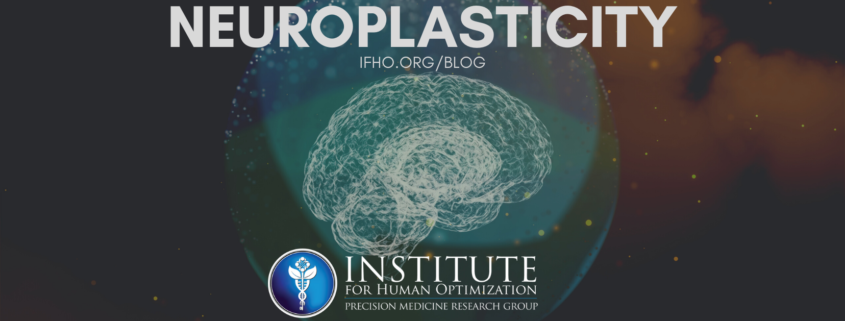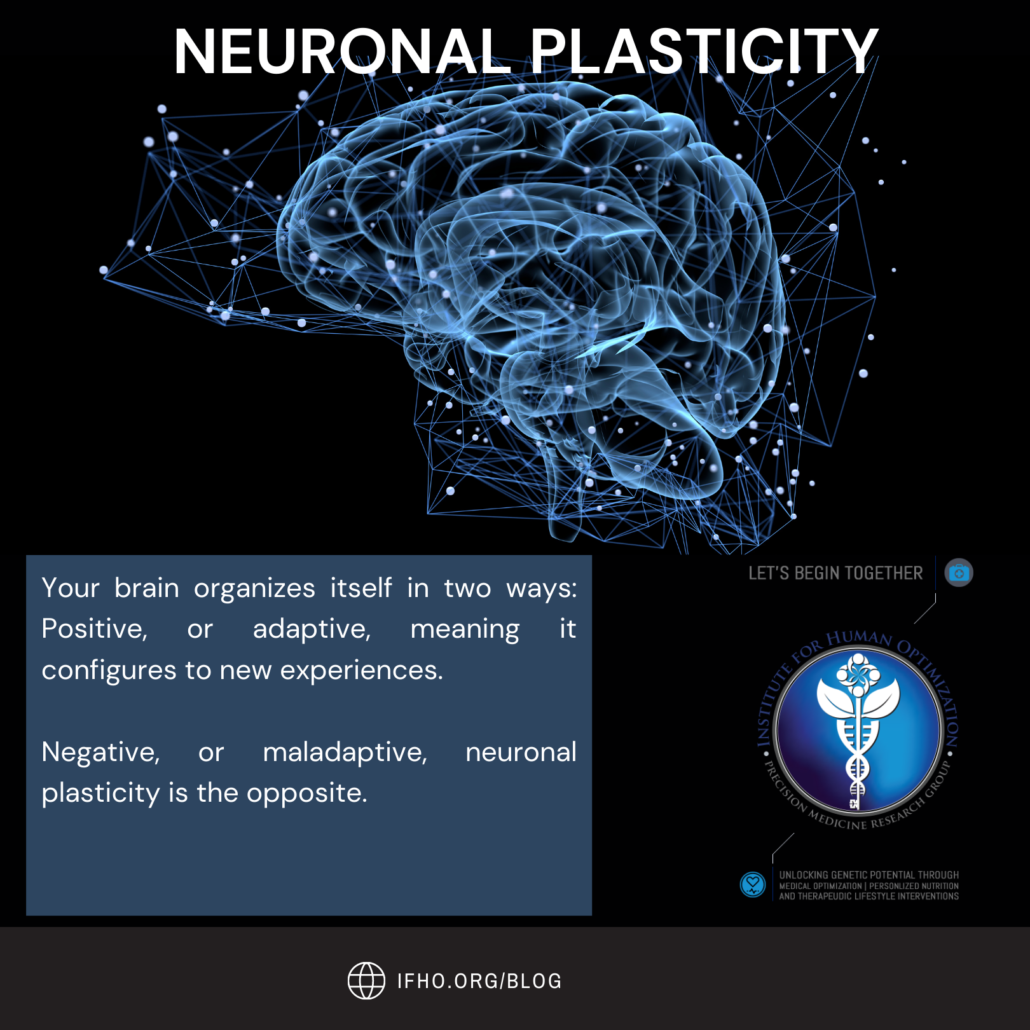Neuronal Plasticity: How Your Thoughts Literally Shape Your Brain
We live in our brains. They shape the way we see the world, the way our personalities express themselves, the way our hearts beat, and organs function. The brain tells us when we’re hungry, when we’re sad, when it’s time to stress or relax. Famous brains throughout history have been responsible for the way we view the universe, the way we view life on this planet, and countless other inventions in medicine, art, and science. In our Brain Health series, we’ve discussed the structures of the brain, the chemical signals that make it work, and how you can take steps to reduce your chances of suffering from neurodegenerative diseases as you age. In our final installment, we discuss neuronal plasticity (how your brain reorganizes itself based on what it sees, knows, and learns) and how you can stay mentally sharp throughout your life.
The human brain is constantly evolving, not just through time, but through our own lifetimes. The brain you’re born with is not the brain you end up with.
Scientists used to believe that the brain was only malleable up to a certain age. It was thought that adults had a certain number of brain cells and they weren’t very good at re-organizing themselves.
But in the early 1900s, this idea was challenged by the father of neuroscience, Santiago Ramon y Cajal. He found that neurons were capable of changing their structures even into adulthood. His claims led to decades of research and the realization that brain organization is not set in stone. It can be “re-wired”, so to speak, depending on what a person experiences throughout their life, what they concentrate on, and how they nourish their body.
This is due to neuron plasticity– the ability of the brain to re-organize and adapt to outside stimulation. When you learn a new skill, adopt a new habit, or are exposed to a life-changing event, the physical structure of your brain changes. The neurons change. Neurotransmitter behavior changes. Your brain literally changes the way it operates based on what you expect of it.
There is a fascinating study on London taxi drivers (before the use of GPS), which showed they had heightened activity in the hippocampus region of the brain compared to non-taxi drivers. The hippocampus is involved with spatial location, therefore, by these experienced taxi drivers constantly having to recall landmarks and spatial clues, they literally built up this part of their brain.
With this knowledge of neuron plasticity, it becomes clear that we have more control over our brain functions that we ever imagined. Habits are simply the ingrained behaviors we’ve cultivated and they can be changed with intention and focus.
Types of Neuronal Plasticity
For every action, there is an equal and opposite reaction. This is Newton’s third law of motion, but it also rings true in regards to neuroplasticity. Your brain organizes itself in two ways:
- Positive, or adaptive, meaning it configures to new experiences. This process is on overdrive when you’re a child, as your brain is learning everything from scratch, even how to interpret light and sound. Neurons are firing, synchronizing with other neurons, and forming connections. Positive neuroplasticity happens when you learn a new language or create a new exercise habit. It’s what enables people to recover from strokes, brain injuries, and even depression and anxiety disorders. It’s what makes your brain resilient.
- Negative, or maladaptive, neuronal plasticity is the opposite. The same systems that re-organize your brain to crave exercise can also create negative thought patterns and habits that wreak havoc on your life. Constantly thinking negatively about yourself creates a neuron pathway for this behavior. The more you engage in negative self-talk, the deeper that pathway runs, the neurons that “fire together, wire together” and it becomes a habit. Negative plasticity can also happen when a person retires, stops learning new skills, and settles into complacency. Because the brain is not using the same neuronal pathways, it begins to shut them down in a process known as “synaptic pruning”. It does this to be efficient and create new pathways that you’ll actually use.
Your brain doesn’t necessarily understand which habits are positive for your life and which are not. Its job is to learn from its environment and create neuron pathways to match it. The habits you choose to cultivate, whether they be hitting the gym regularly or biting your nails, literally change the way your neurons interact with each other.
Your brain accomplishes this mainly through neurotransmitters such as dopamine. When you do something you want to do, dopamine is released, making you feel good. Each time you repeat the action, dopamine gets released earlier, until just thinking about doing it causes a surge. This is what we call “motivation” and is an essential process for remapping the brain. Neurons that fire together, wire together.
Long-Term Synaptic Potentiation
Long-term potentiation (LTP) is the constant strengthening of synapses based on consistent patterns of activity. It goes beyond negative and positive neuroplasticity, creating long-lasting experience-dependent changes in the efficacy of synaptic transmission. This could be the key to remaining mentally “sharp” as you age.
Interestingly, a breakthrough study published in the Proceedings of the National Academy of Sciences in 2004 demonstrated that the simple act of thinking could cause long-term potentiation changes in the brain.
“Learning-induced potentiation of synaptic strength is also accompanied by an increase in the threshold for further synaptic enhancements.”
Lüscher, C., & Malenka, R. C. (2012). NMDA receptor-dependent long-term potentiation and long-term depression (LTP/LTD). Cold Spring Harbor perspectives in biology, 4(6), a005710. https://doi.org/10.1101/cshperspect.a005710
It’s a complicated process that researchers are still trying to figure out. But essentially, the more you concentrate on doing things that are good for you, the deeper those habits are entrenched in your brain. This is why as we age, it becomes harder to change things about our lifestyles and personalities. However, neuronal plasticity is not reserved for the young. Anyone can take this knowledge and use it to hack the brain.

Can You Really “Re-wire” Your Brain?
There’s a myriad of brain supplements, apps, and how-to guides claiming to help you “re-wire” your brain- but your brain doesn’t actually have “wires”. It’s a vast array of structures, chemical reactions, and impulses that do not act independently from one another. It’s a living, evolving organ that will literally re-organize itself to meet your demands.
So what do you demand of it? Do you make your brain read and take in new information? Do you allow your brain to quiet and be in the moment? Do you load your brain with to-do lists? Do you concentrate on the things that are wrong in your life or the things you enjoy?
If you find yourself burdened with mood disorders, poor cognitive performance, or even just want to sustain mental clarity into old age, there are proactive steps you can take to align your brain with your goals.
- Supplement. Just like any other part of your body, your brain must have the correct fuel to work properly. At the Institute for Human Optimization, we recommend supplements with scientific data to back them up. Taking a reliable multi-vitamin to cover the basics is always a good idea. There are also supplements you can use for brain health specifically.
One of these substances is Alpha-GPC, a natural choline compound found in the brain. It’s also a precursor for acetylcholine, a vital neurotransmitter, and has been studied for its potential for the treatment of Alzheimer’s disease and dementia.
Choline is a nutrient that improves focus and boosts cognitive performance. It can be obtained from a diet high in whole vegetables, fruits, and whole grains, but statistically, westerners do not get enough choline from their food and should supplement if possible. - Meditate. You don’t have to be a Buddhist monk to reap the benefits of meditation. While many people link this mental exercise with spirituality, there are countless studies measuring the physical benefits of sitting still and trying not to think. One study shows meditators had more blood flow in the prefrontal cortex, the part of the brain responsible for decision making and cognitive abilities. Another study found that meditation increased serotonin production, making it a possible treatment for depression and anxiety which are often a symptom of imbalanced serotonin levels. There are so many free meditation apps and videos out there, but all you really need is 20 minutes a day, a quiet room, and your breath.
- Keep learning. “A brain at rest tends to stay at rest”. That’s Newton again, but still relevant. Your brain needs stimuli to make neurons fire. Doing the same tasks everyday fire up the same neurons in the same patterns, leading to synaptic pruning of all the pathways you’re not using. This is why people who move to a new country often become “rusty” in their native language if they’re not speaking it often. The brain says, “I need these new neural pathways to speak this language, but these others haven’t been used in a while- let’s re-wire.”
The good news is that by knowing this, you can consciously choose which pathways you want to keep and which ones you allow your brain to prune. You can make it a goal to learn new skills throughout your life, keeping your brain resilient and life exciting. - Think positive. Your neurons fire according to your thoughts. If you think you’re in danger, adrenaline is released to help you fight or run. If you think you’re in love, dopamine and serotonin are released to make you feel happy and content. The more you think about something, the deeper you dig the pathway that repeats those thoughts.
Therefore, it’s beneficial to use our thoughts to help our brains. Focusing on positive things, things you’re grateful for, and taking time to talk nicely to yourself help your brain wire itself to keep doing the same. Neurons that fire together, wire together. So next time you’re feeling anxious or stressed, try naming three things you’re happy about. Make those “positive feeling” neurons fire. The more you practice this, the easier it’ll get.
At the Institute for Human Optimization, we believe longevity shouldn’t be measured just by the length of life, but by the quality. Keeping your mental faculties working correctly and avoiding neurodegenerative disease is one of our key points when working with patients. Every person has their own unique relationship with their brain and our goal is to make it a positive, long-lasting one.
To discuss how we can help optimize your brain health, you can schedule a discovery call or check out the rest of our brain health series on the blog.






Leave a Reply
Want to join the discussion?Feel free to contribute!